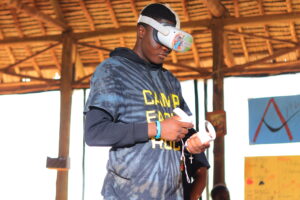Celebrate Astronomy Day!
Celebrate the wonders of the cosmos with Astronomy Day, an annual event that encourages people of all ages to look up to the sky, and wonder about our universe. Astronomy Day is celebrated internationally twice a year, on the Saturday closest to the First Quarter Moon between the months of April and May, and again on the Saturday closest to the Quarter Moon between September and October.
Astronomy Day was founded in 1973 by Doug Berger, the president of the Astronomical Association of Northern California. The holiday was founded with the purpose of raising the interest of astronomy with the general public, by providing easy access to astronomical equipment like telescopes.
What is Astronomy?
Astronomy is the scientific study of everything beyond the Earth’s atmosphere, such as stars, planets, moons, comets, and other galaxies. Astronomers use a variety of tools, like telescopes, satellites, and computer simulations to explore the universe and look for answers to its many mysteries. These mysteries range from the origins of our galaxy, to the search for extraterrestrial life!
 Astronomy is actually one of the oldest sciences, and has been studied for thousands of years! Ancient civilizations, such as the Egyptians, Greeks, and Romans, looked up to the night sky and studied the patterns in the stars. These patterns are called constellations, and many of them have been given names you’ve likely heard of!
Astronomy is actually one of the oldest sciences, and has been studied for thousands of years! Ancient civilizations, such as the Egyptians, Greeks, and Romans, looked up to the night sky and studied the patterns in the stars. These patterns are called constellations, and many of them have been given names you’ve likely heard of!
These ancient civilizations also studied the movements of the stars and planets, and were able to create calendars that could predict celestial events. Even our modern day calendar is based on an ancient Roman lunar calendar!
How to Celebrate Astronomy Day
Celebrating Astronomy Day is a great way to engage with the wonders of the universe, and foster an appreciation for the science. Here are just a few ideas of how to celebrate Astronomy Day:
Host a Stargazing Event:
Grab a telescope or binoculars, and host a stargazing event for your friends and family! For the best view of the night sky, take a trip together to a location far away from city lights, and you will have a perfect view of the sky without light pollution!
Attend a Local Stargazing Event:
If you don’t own or have access to a telescope, many observatories, universities, and astronomy clubs around the globe set up telescopes in public areas and allow anyone to observe the skies during the day and night. After all, the mission of Astronomy Day is “bringing astronomy to the people.”
TryEngineering Lesson Plans:
To engage students in Astronomy Day, utilize some of TryEngineering’s free lesson plans! The lesson plan Infrared Investigations focuses on how engineers use infrared technology to create various equipment and systems, including telescopes that are able to penetrate dusty regions of space, and detect low temperature objects like planets orbiting distant stars!
Another fun lesson plan is Blast Off! This lesson focuses on aerospace engineering and how space flight is achieved from an engineering vantage point. Students will use what they have learned when they get to build and launch their own model rocket!




 There were a few challenges that had to be overcome to make this program a success, one of which was the change in VR perception. Many participants had viewed VR as a solely western concept, but the K12 Initiative successfully shifted this perspective, highlighting the global relevance and accessibility of VR. Another challenge was Internet of Things (IoT) enlightenment. Participants discovered new insights into sensors during the IoT session on traffic lights and police sirens. Despite initial perceptions of IoT complexity, the K12 Initiative simplified the concept effectively.
There were a few challenges that had to be overcome to make this program a success, one of which was the change in VR perception. Many participants had viewed VR as a solely western concept, but the K12 Initiative successfully shifted this perspective, highlighting the global relevance and accessibility of VR. Another challenge was Internet of Things (IoT) enlightenment. Participants discovered new insights into sensors during the IoT session on traffic lights and police sirens. Despite initial perceptions of IoT complexity, the K12 Initiative simplified the concept effectively.







